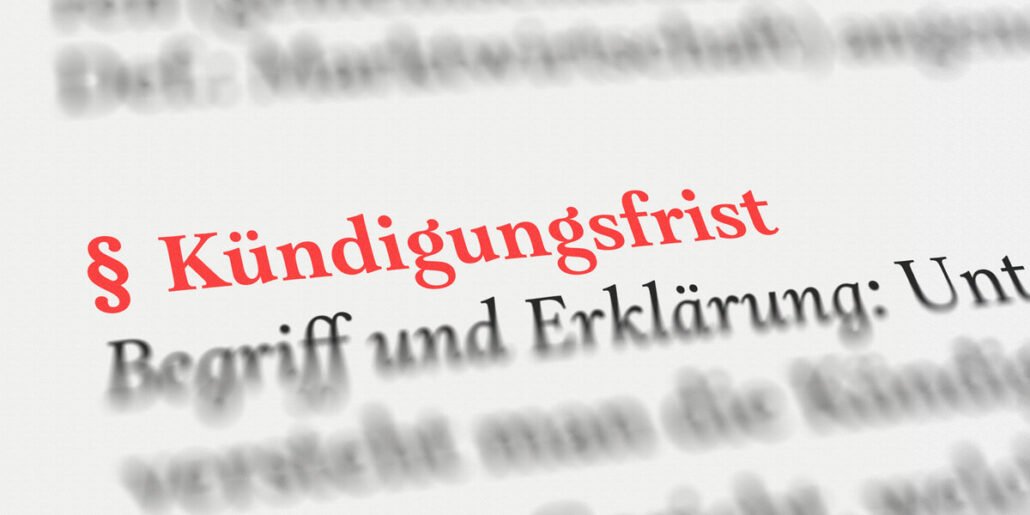

When an employer (or employee) terminates an employment contract, it does not end immediately. First, the ‘notice period’ must expire, i.e. the period between termination and the end of the contract. This notice period is almost always specified in the employment contract (or in the collective agreement). Only if no provisions have been made there does the statutory notice period apply. Depending on whether the employer or employee gives notice and how long the employment contract has been in place, the statutory notice period can also be six months or longer. And during this time, the employer must continue to pay wages/salary. As an employee, you should know your rights in order to avoid costly mistakes, for example when concluding a termination agreement. The following article summarises the most important aspects of contractual and statutory notice periods for employers and employees (including tables of notice periods).
Unfairly dismissed in Germany?
Check your severance pay now – you have only 3 weeks to preserve your severance package!
- The notice periods are usually clearly specified in the employment contract (or collective agreement). Only if there are no (valid) provisions there do the statutory notice periods apply.
- The statutory notice periods differ depending on who gives notice:
- If the employee gives notice, the statutory notice period is four weeks, regardless of the length of the employment relationship.
- If the employer terminates the employment relationship, staggered statutory notice periods apply. The longer an employee has been employed by the company, the longer the notice periods for the employer.
- However, how long you actually have to continue working after termination depends not only on the notice period, but also on any remaining holiday entitlement and any agreements made (e.g. regarding time off in lieu).
Contents
Notice periods for ordinary termination
If employers or employees wish to terminate an employment relationship, they must observe certain notice periods in the case of normal (‘ordinary’) termination. These notice periods are almost always specified in the employment contract. They may also be stipulated in collective agreements. Only if there are no provisions in either the employment contract or a collective agreement do the statutory periods of notice under the German Civil Code apply. The statutory periods of notice depend primarily on who gives notice. While the same statutory periods of notice always apply to employees, the period of notice for employers depends on the length of service (details below in the table of periods of notice).
However, how long you actually have to continue working after being dismissed depends not only on the notice period, but also on other factors, such as any remaining holiday entitlement and agreements made in individual cases. When an employer dismisses an employee, a period of leave of absence is often agreed – either revocable, i.e. with a right of recall, or irrevocable. Holiday and overtime can be taken into account if this has been agreed.
Exception: If a collective agreement applies, the provisions on notice periods contained therein often take precedence. A collective agreement can extend or shorten the notice periods. For example, the collective agreement for the public sector regulates notice periods that deviate from the statutory requirements. However, if the employment contract stipulates a longer notice period for the employee, this applies (principle of favourability). Information on collective agreements and their notice periods can be obtained from trade unions and works councils.

How much severance pay are you entitled to? Calculate now!
- Calculate your individual severance pay for free
- Calculation of the standard payment up to a very high settlement
- Get a strategy to maximise your severance pay
Statutory notice period for employees
An employee can give ‘ordinary’ notice of termination of their employment relationship with four weeks‘ notice in accordance with the statutory notice period. According to the law, termination is possible on the 15th or at the end of the month. During the probationary period, the employee can terminate the employment relationship on any day with two weeks’ notice.
Priority of contractual agreements
However, an individual agreement in the employment contract takes precedence over the statutory provisions. And in almost all employment contracts, the notice period for employees is precisely regulated – almost always with longer periods. These are usually 1-3 months, in some cases even longer. There is no statutory limit on the maximum notice period for employees. However, according to case law, there are upper limits. The Federal Labour Court (BAG) considered a period of three years to be too long and ruled that such a period would be invalid. A reduction in the statutory notice periods to the detriment of the employee is not permitted.
Exceptions apply to temporary workers who are only employed for up to three months. Fewer termination dates may also be agreed in the employment contract. Instead of termination at the end of the month, termination at the end of the quarter is often agreed. In this case, ordinary termination is only possible four times a year.
Exception: small businesses
Special provisions apply to certain small businesses. These may deviate from the standard notice periods by contractual agreement. However, the four-week notice period also applies here. In addition, it must be taken into account that the employment contract may not stipulate a longer notice period for the employee than for the employer. A longer notice period for the employer is, however, also permissible here.
Notice period table
If the notice periods for employees and employers are specified in the employment contract, the statutory period is usually replaced by a uniform longer period (usually 1-3 months). This is permitted if both parties are treated equally. If, on the other hand, nothing is stipulated in the employment contract (in exceptional cases) or reference is made to the statutory notice periods, the statutory notice period for employees is the same after 2 years as after 20 years:
| Length of employment | Notice period |
| 0-6 months | 2 weeks to any date |
| Ab 6 months | 4 weeks to the 15th or end of the month |
As can be seen from the notice period table, the notice period after the probationary period is always the same for employees, namely 4 weeks to the 15th or to the end of the calendar month. However, as mentioned above, the statutory period is usually replaced by a uniform longer period in the contract, typically 1-3 months.
Statutory notice periods for employers
For employers, on the other hand, extended statutory notice periods are provided for by law, as employees are considered to be more vulnerable. The statutory notice period for employers depends on the length of service of the employee. If, for example, the employment relationship has reached a duration of five years, a notice period of two months to the end of the month applies. After eight years of employment, this period is extended to three months. The exact notice periods for employers can be found in the following notice period table:
| Length of employment | Notice period |
| 0 to 6 months | 2 weeks to any day |
| 7 months to 2 years | 4 weeks to the 15th or end of the month |
| From 2 years | 1 month |
| From 5 years | 2 months |
| From 8 years | 3 months |
| From 10 years | 4 months |
| From 12 years | 5 months |
| From 15 years | 6 months |
| From 20 years | 7 months |
As can be seen in the notice period table above, the notice period can be six months or more. In principle, all periods of employment must be taken into account when calculating the length of service. However, as mentioned above, the statutory period is usually replaced by a uniform, longer contractual period, typically 1-3 months. Of course, it can also be contractually agreed that the longer statutory notice periods set out in Section 622 (2) of the German Civil Code (BGB) also apply to the statutory notice period for employees.
Do you need help with German labor law?
Get a free initial consultation now – with an expert on German labor law!
Deviating provisions and special cases
If a valid collective agreement exists and this stipulates notice periods that deviate from the statutory provisions mentioned above, this shall take precedence. In certain cases, this may also result in shorter notice periods than those required by law.
During the probationary period, which may last for a maximum of six months, it is possible to terminate the employment relationship with two weeks’ notice.
In addition to the general regulations, there are special statutory notice periods for special cases, for example:
- A minimum notice period of four weeks must be observed when terminating the employment of a severely disabled employee.
- Apprentices can be dismissed without notice at any time during the probationary period in accordance with Section 22 of the Vocational Training Act (BBiG).
- According to Section 113 of the Insolvency Act (InsO), an insolvency administrator must observe a notice period of three months to the end of the month, unless a shorter period has been agreed in the contract.
Extreme case: Termination without notice
In exceptional cases, termination without notice (‘extraordinary termination’) is possible, namely if there is a serious reason that makes it unreasonable for the employer (or employee) to continue the employment relationship until the end of a normal notice period. If termination without notice (‘extraordinary termination’) is effective, the employment relationship ends with immediate effect, without observing a notice period. This can have serious consequences for employees, such as the abrupt loss of income or a waiting period for unemployment benefits.
However, strict legal requirements must be met for such a termination to be legally effective. In particular, there must be a so-called ‘important reason’ that makes it unreasonable for the employer to continue the employment relationship until the regular expiry of the notice period. Since the requirements of the labour courts in such cases are very high, dismissals without notice often fail in court. In addition, the dismissal must be made within two weeks of the employer becoming aware of the decisive circumstances. Furthermore, dismissal without notice is often invalid without prior warning.
However, if the termination without notice is effective, the employment relationship ends with immediate effect, meaning that from this point onwards, there is no longer any entitlement to wages or salary. In addition, the Employment Agency often imposes a waiting period for receiving unemployment benefits in such cases. Anyone who wishes to defend themselves against termination without notice must file an action for unfair dismissal with the labour court within three weeks of receiving the notice of termination.

Free initial consultation with a specialist lawyer
- 15min free initial consultation with a lawyer
- Prompt online appointment via Calendly or quick call-back
- Strategy for negotiating your severance pay
Frequently asked questions (FAQ)

Free initial consultation with a specialist lawyer
- 15min free initial consultation with a lawyer
- Prompt online appointment via Calendly or quick call-back
- Strategy for negotiating your severance pay
- Termination of employment contract: 7 steps you should follow!
- Action for unfair dismissal: costs – how much you really have to pay
- How to calculate the notice period in Germany correctly
- What is the “blocking period” for unemployment benefits in Germany?
- Termination without cause in Germany – is that allowed?




